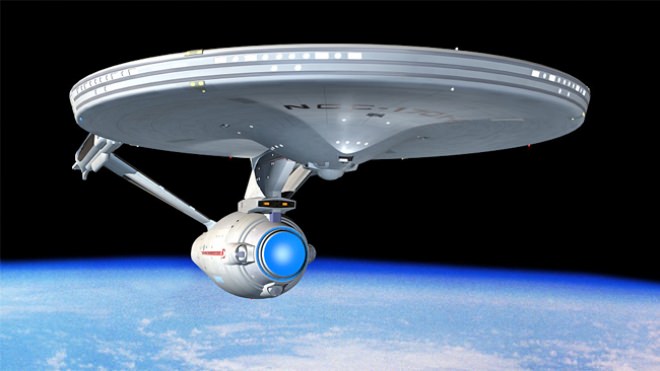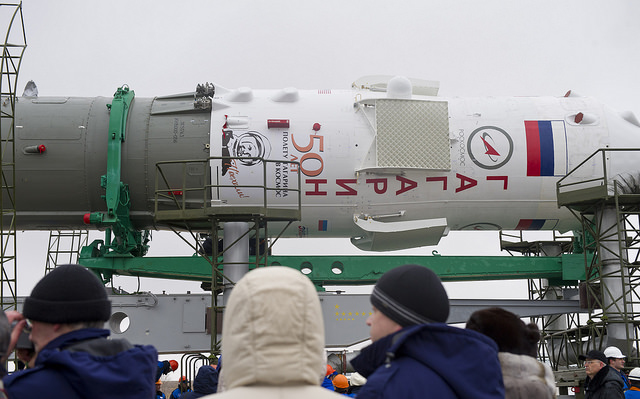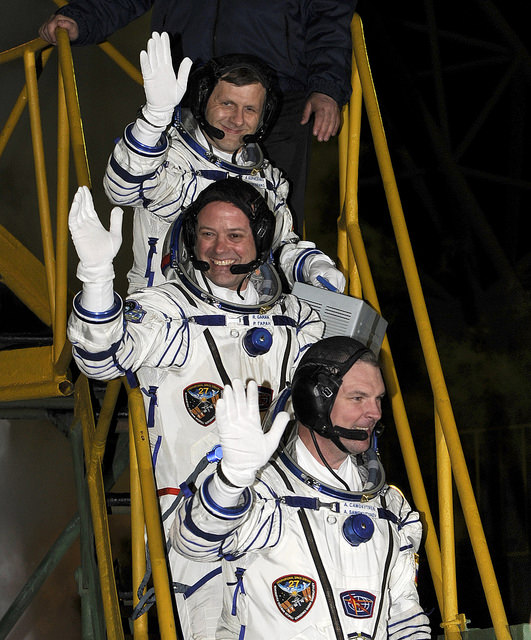Videographers David Gonzales and Mike Deep filmed Endeavour’s final launch with two cameras from the Kennedy Space Center Press Site, and put this video together for Universe Today. They did a great job of capturing what a shuttle launch sounds like, from the countdown, to the cheering of the crowd, to the crackling and popping of the launch itself.
Continue reading “The Sights and Sounds of Endeavour’s Final Launch”
DARPA Wants Your Ideas for a 100-Year Starship
[/caption]
The idea for a 100-year starship has been tossed around recently, and now DARPA the Defense Advanced Research Projects Agency, has put out a Request for Information (RFI) looking for ideas about how a long-term human mission to boldly go out to the stars could possibly happen. It’s been estimated that such a mission would cost over $10 billion, and the idea has gotten $100,000 from NASA and $ 1 million from DARPA – which means that as of now it is just that, an idea.
Pete Worden, the Director of NASA’s Ames Research Center announced the idea last fall, and it received plenty of coverage, but not much publicized research on how the idea could possibly come to fruition. Worden optimistically said he expected to see the first prototype of a new propulsion system within the next few years, but that seem unlikely given NASA’s frozen budget and a Congress that doesn’t seem very forward-looking in their vision for what NASA should be doing. But perhaps DARPA’s input could have some leverage.
There would be several technological obstacles to overcome, such as how to create an artificial gravity so that those aboard the ship wouldn’t experience the muscle and bone loss that astronauts on the ISS have after just six months in space. Then there’s how to manufacture food, and create other things the crew might need while they are out in the middle of nowhere. Those are just a few examples of what would need to be dealt with.
But anyway, a journey starts with a single step, and so if you’ve got any ideas, here’s DARPA’s RFI (hurry, you’ve only got until June 3, 2011!):
DARPA is seeking ideas for an organization, business model and approach appropriate for a self-sustaining investment vehicle in support of the 100 Year StarshipTM Study. The 100 Year StarshipTM Study is a project seeded by DARPA to develop a viable and sustainable model for persistent, long-term, private-sector investment into the myriad of disciplines needed to make long-distance space travel practicable and feasible. The genesis of this study is to foster a rebirth of a sense of wonder among students, academia, industry, researchers and the general population to consider “why not” and to encourage them to tackle whole new classes of research and development related to all the issues surrounding long duration, long distance spaceflight. DARPA contends that the useful, unanticipated consequences of such research will have benefit to the Department of Defense and to NASA, and well as the private and commercial sector. The information obtained will be used for planning and acquisition strategy development. DARPA will use the information obtained as a result of this RFI on a non-attribution basis. Providing data and information that is limited or restricted for use by the Government for that purpose would be of very little value and the inclusion of such restricted/limited data/information is discouraged. Responses as a single file in Adobe PDF electronic format can be submitted to [email protected] by 12:00 pm (noon) Eastern Time, Friday, June 3, 2011. For complete details of this notice, please refer to the attachment, “RFI – 100 Year Starship Study“.
Rare and Unpublished LIFE Photos of Alan Shepard’s Historic Flight
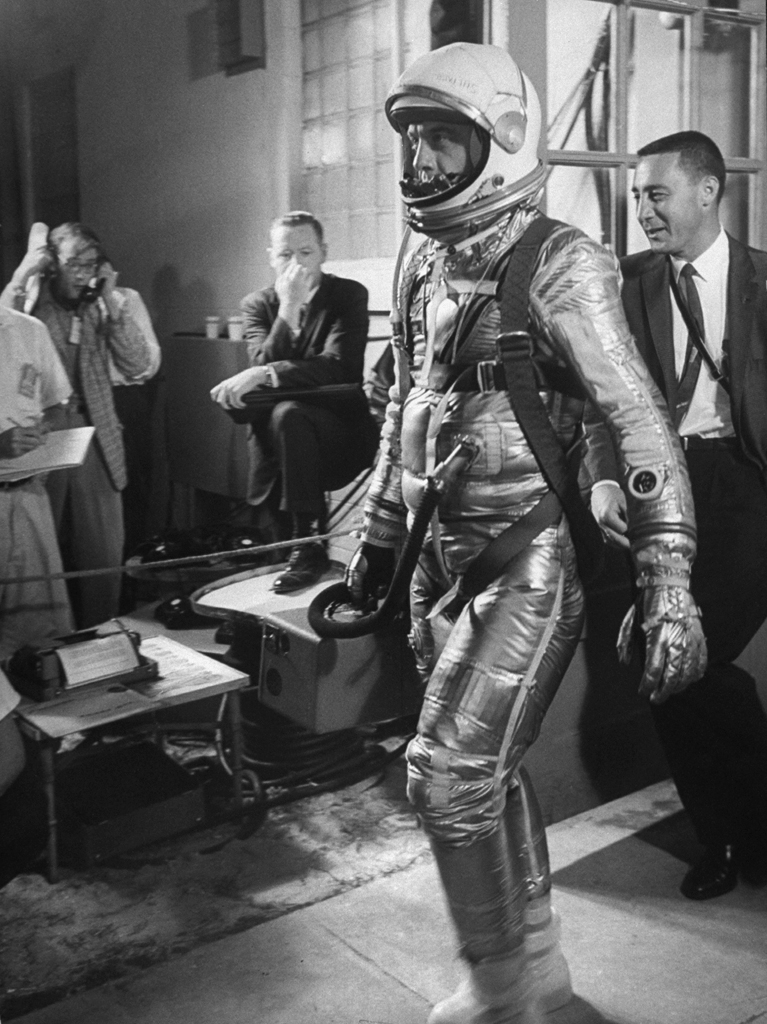
[/caption]
If you follow me on Twitter, you may have seen how I was oohing and aahing about a wonderful set of rare and never-seen photographs of Alan Shepard, John Glenn, and the other Mercury astronauts released by LIFE.com in honor of the 50th anniversary Alan Shepard’s flight on May 5. Maybe LIFE saw my Tweets, too, as they contacted us, giving Universe Today permission to publish a few. Above, Shepard strides to the launchpad early on May 5 1961, with Gus Grissom close behind. Shepard reportedly joked to technicians who rode with him to the launch pad: “You should have courage and the right blood pressure” if you want to succeed as an astronaut. “And four legs … You know, they really wanted to send a dog, but they decided that would be too cruel.” In Shepard’s right hand: a portable air conditioner to cool the inside of his pressure suit before he enters the capsule.
See more below.
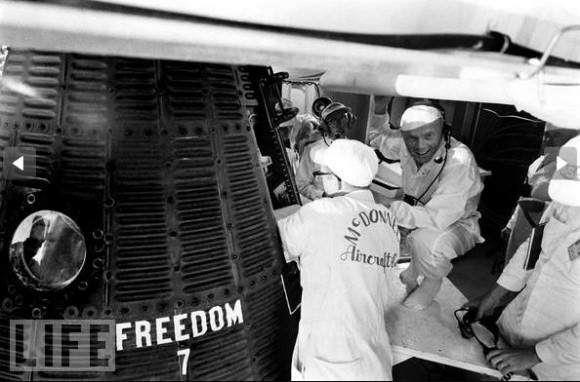
In this previously unpublished photo, John Glenn crouches near Shepard’s capsule, Freedom 7, prior to launch. In the book “Light This Candle: The Life and Times of Alan Shepard,” author Neal Thompson portrayed the fierce competitiveness between Shepard and Glenn over who would be the first astronaut in space, which sometimes bordered on the two disliking each other. But as the first flight approached, Shepard and Glenn spent a lot of time together training, and formed a bond. Glenn even put a few items in Shepard’s Freedom 7 capsule as a joke to lighten the intensity of the day, and this image shows Glenn’s excitement and joy as his fellow astronaut enters the spacecraft. LIFE photographer Ralph Morse said of NASA’s choice for who was making the first flight: “You know, I presumed, at that point, that they were saving Glenn, that having him circling the Earth for the first time would be better press for NASA. But you don’t know about these things. They had their own reasons, of course — complicated reasons, based on skills and personality and temperament — for choosing one man ahead of another.”
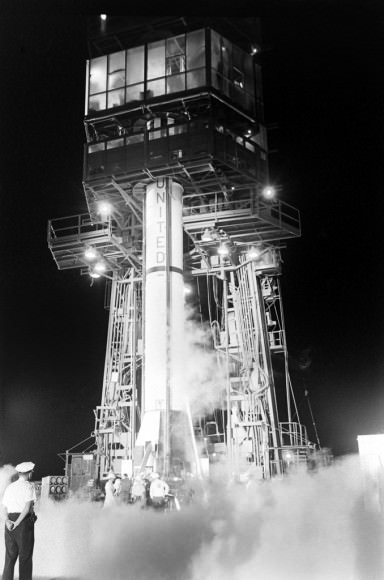
This previously unpublished image shows Shepard’s Redstone rocket before liftoff. “I never have been my own favorite subject,” Shepard once told LIFE, when asked how he felt about the rewards and dangers inherent in Project Mercury. “And I don’t think I’ve found anything new about myself since I’ve been in this program. We were asked to volunteer, not to become heroes. As far as I’m concerned, doing this is just a function of maturity. If you don’t use your experience, your past is wasted, and you are betraying yourself.”
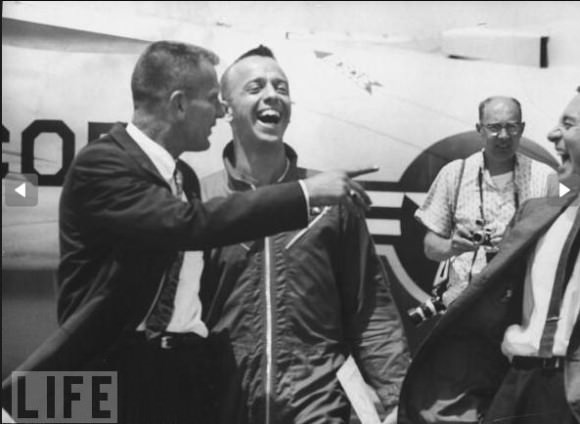
This is my absolute favorite image of this set: Shepard shares a laugh with fellow astronauts Gus Grissom (right) and Deke Slayton upon his arrival at Grand Bahama Island, shortly after his successful flight and splashdown. Oh to be a fly on the wall to know what they were laughing about!
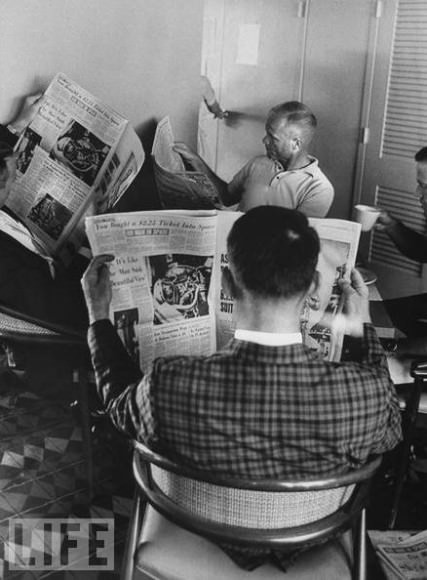
No internet, no instant messaging, no Twitter or Facebook. The Mercury astronauts and the rest of the world had to wait for the next day’s newspapers to come out to read of Alan Shepard’s heroics. “Though the U.S. still has far to go to catch up with the Russians in space,” LIFE magazine noted in its May 12, 1961 issue, “Shepard went a long way toward lifting American heads higher.”
See many more images on the LIFE.com gallery. Thanks again to LIFE for allowing us to post these images.
Astronaut On Board ISS Gets Word of Mother’s Death
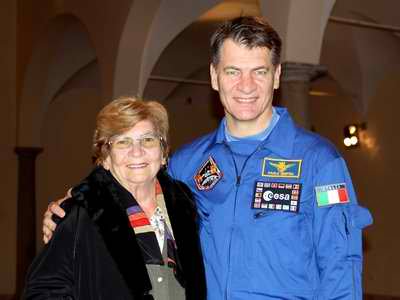
[/caption]
ISS astronaut Paolo Nespoli from Italy received some sad news while in orbit on the International Space Station: his mother, Maria Motta, has died following an illness. She was 78. This is the second time an ISS astronaut has lost a mother during a long duration mission. U.S. astronaut Daniel Tani’s mother was killed in an accident during the midst of Tani’s ISS expedition in 2007. Nespoli is not scheduled to return to Earth for another three weeks.
Nespoli knew his mother was ill. According to the Associated Press, Nespoli’s family members who live near Milan, Italy have been able to stay in touch with Nespoli with a video system set up in his mother’s home by the European Space Agency. A funeral service will be held on Wednesday, and officials at the European Space Agency said that in such an instance it might be possible to set up a satellite hookup so the absent astronaut could participate in the services.
Just before Nespoli launched on his first mission to space in 2007, his father passed away.
UPDATE: At 15:05 CEST on Wednesday, May 4, the ISS will fly over @Astro_Paolo’s hometown and the crew will observe 1 minute silence. ESA is asking anyone who wishes to participate on their own to please do so.
Anyone interested in expressing their condolences to Paolo can send cards to:
Paolo Nespoli
ESA – European Astronaut Centre
Linder Höhe
D-51147 Cologne
Germany
or on Twitter:
@Astro_Paolo
The STS-134 shuttle will bring Italian astronaut Roberto Vittori to the space station, and Italians were anticipating having two of their countrymen aboard the ISS at once, and plans were in place for Pope Benedict to call the two astronauts while they were in orbit. The technical problems with shuttle Endeavour has caused a delay in the launch, however, with NASA officials saying the shuttle won’t be able to launch any earlier than May 10. Italian officials are hopeful the shuttle won’t be delayed further so that the meetup in space will still be possible.
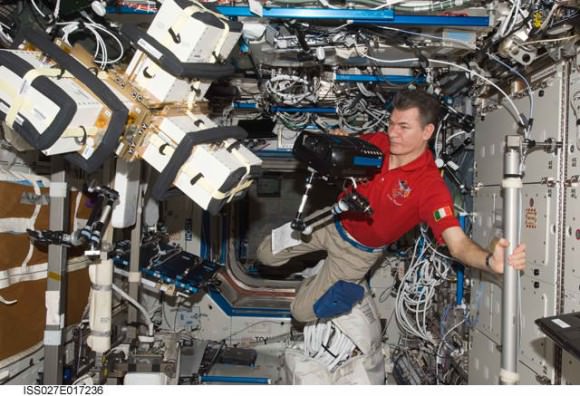
Gallery: 10 Years of Canadarm2, Construction Crane in Space
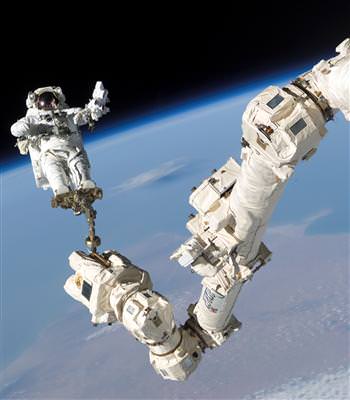
[/caption]
On April 19, 2001, space shuttle Endeavour’s STS-100 mission launched to the space station, and in the payload bay was Canadarm2, a larger, more robust successor to the shuttle’s Canadarm. The Space Station Remote Manipulator System (SSRMS) is a sophisticated “construction crane,” and is responsible for much of the successful building of the ISS — module by module — in space.
“She is without a doubt one of the most critical components on board station having participated in the construction of the spacecraft that is on orbit today,” said Mike Suffredini, Program Manager of the International Space Station. “Twenty-nine missions have been supported by Canadarm2, two of them capturing and berthing the HTV vehicle, and in all that time with absolutely flawless performance. Without her we couldn’t have gotten to where we are today.”
See a gallery of images of Canadarm2’s 10 years in the space construction business.
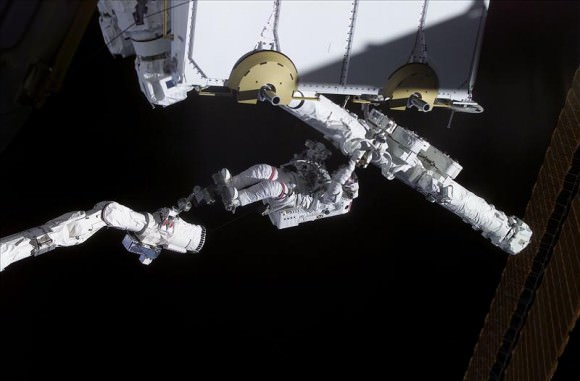
Canadarm2 was installed on the ISS by astronaut Chris Hadfield during the first spacewalk by a Canadian. Canadarm2 has unloaded hundreds of tons of equipment and supplies ferried by the shuttle and assisted almost 100 spacewalks. Endeavour’s last flight later this month will mark Canadarm2’s 28th Shuttle mission.
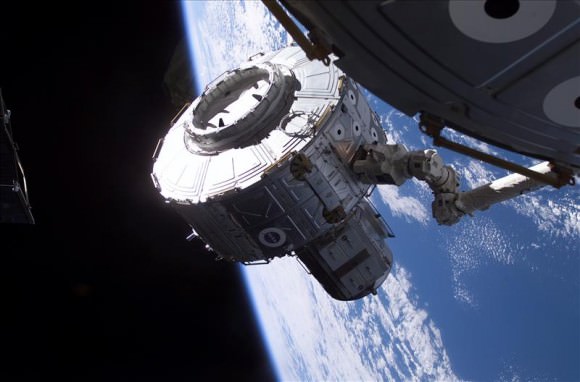
The Canadian Space Agency says that Canadarm2’s role on the ISS will expand as the orbital lab nears completion: in addition to performing routine maintenance, the robotic arm will make more frequent “cosmic catches,” where it will capture, dock and later release visiting spacecraft, as it has done with the HTV. When the space shuttle retires, reusable commercial spacecraft, like SpaceX’s Dragon and Orbital’s Cygnus, will be used to bring supplies and equipment to the ISS. Canadarm2 will capture each of these visiting vehicles. In late 2011 and early 2012, Canadarm2 will capture a series of 6 commercial spacecraft in just 7 months, beginning with the Dragon spacecraft, currently scheduled to arrive in October 2011.
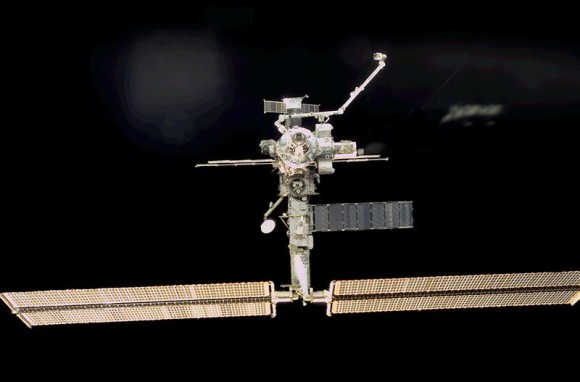
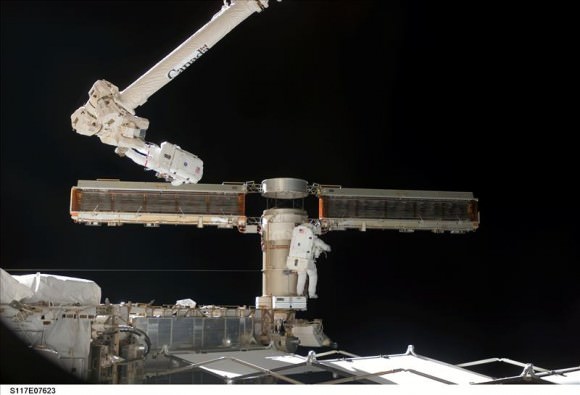
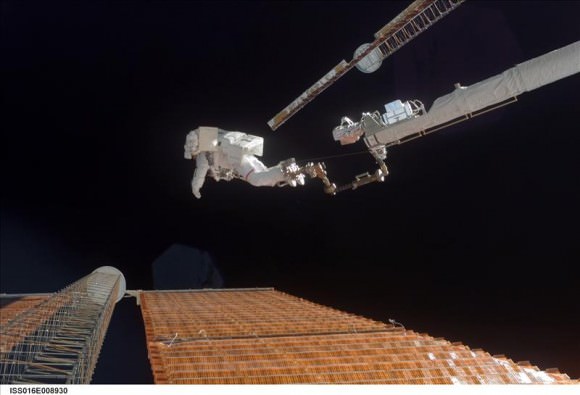
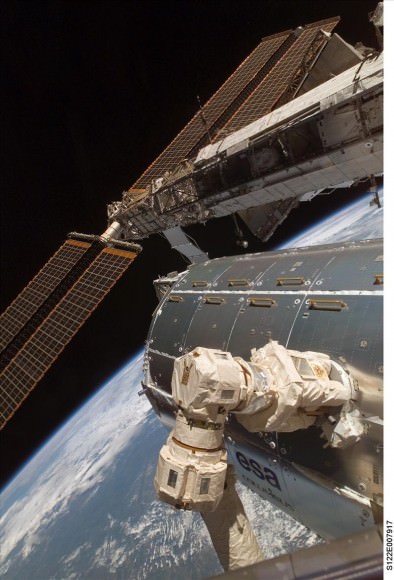
More info on the SSRMS and how it was built:
The Expedition 27 crew on board the ISS pay tribute to 10 years of the SSRMS:
Movie Premiere: First Orbit
50 years ago Yuri Gagarin became the world’s first human to go into space. What did he see? He described it fairly well, but there are limited pictures and no video from his time in orbit. Now, through a unique collaboration between a filmmaker and ESA astronaut Paolo Nespoli on board the International Space Station, high definition video of what Gagarin might have seen has been woven together with historic recordings of the flight (subtitled in English) to create a new, free film called “First Orbit” that has now been released. This movie is a real time recreation of Yuri Gagarin’s pioneering first orbit, shot entirely in space from on board the International Space Station. The film combines this new footage with Gagarin’s original mission audio and a new musical score by composer Philip Sheppard. For more information about the movie see the First Orbit website.
Also, the @FirstOrbit twitter feed will tweet the original communications in “real” time (50 years later) on April 12, recreating the events as Gagarin flew on Vostok 1 flew from 6:07-7:55 UTC.
‘Gagarin’ Launches to Space Station
A Russian Soyuz spacecraft launching from the very same launch pad used by Yuri Gagarin when he became the first human in space 50 years ago blasted off from the Baikonur Cosmodrome in Kazakhstan, just a week shy of the April 12th anniversary. The launch took place on time on April 5, 2011 4:18:20 a.m local time (6:18:20 p.m. EDT on April 4), sending two cosmonauts and one astronaut to the International Space Station: Soyuz commander Alexander Samokutyaev, flight engineer Andrey Borisenko and NASA astronaut Ron Garan. The rocket bore the image (see below) and name of Gagarin to celebrate his historic flight.
[/caption]
The crew should reach the ISS on Wednesday.
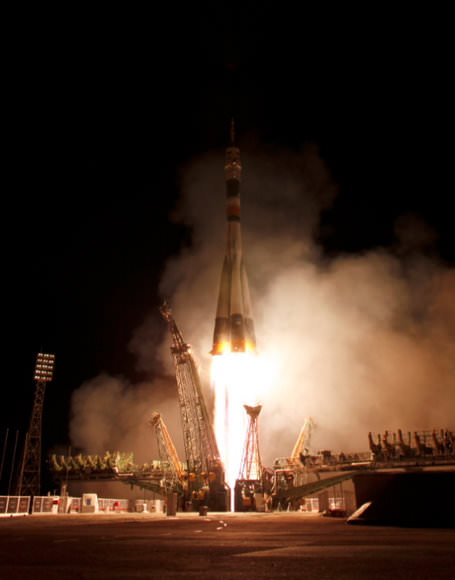
Expedition 27 crew members from top, Russian Flight Engineer Andrey Borisenko, NASA Flight Engineer Ron Garan, and Soyuz Commander Alexander Samokutyaev wave farewell from the bottom of the Soyuz rocket prior to their launch to the International Space Station from the Baikonur Cosmodrome in Baikonur, Kazakhstan, on Tuesday, April 5, 2011. Photo Credit (NASA/Carla Cioffi)
What Did Gagarin See on His Historic Flight?
50 years ago, April 12th, Yuri Gagarin became the world’s first human to go into space. What did he see? He described it fairly well, but there are limited pictures and no video from his time in orbit. Now, through a unique collaboration between a filmmaker and ESA astronaut Paolo Nespoli on board the International Space Station, high definition video of what Gagarin might have seen has been woven together with historic recordings of the flight (subtitled in English) to create a new, free film that will be released on the 50th anniversary titled First Orbit. Above is the trailer for the film. What a perfect way to celebrate this historic moment.
“Circling the Earth in my orbital spaceship I marveled at the beauty of our planet. People of the world, let us safeguard and enhance this beauty — not destroy it!” — Yuri Gagarin.
Continue reading “What Did Gagarin See on His Historic Flight?”
Unique Perspective: Shuttle Launch as Seen from Airplane, Balloon, and Freefall
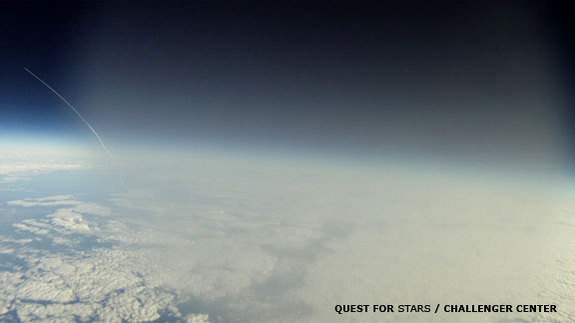
I thought I had a great view of space shuttle Discovery’s final launch, seeing it from the Kennedy Space Center press site. But there were a few other people who had a pretty unique perspective on the launch. A passenger on an airplane, Neil Monday, who was flying out of the Orlando, Florida airport, recorded the shuttle launch with his iPhone, above. That is just awesome. Want more unique views of the launch?
[/caption]
The students from Quest For Stars who were attempting to capture an image of Discovery’s launch from a high altitude balloon (see our preview article) were successful and the team has released a couple of images, including the one above. They say they will be releasing the “best of the best” of their images later this week at the Next Generation Suborbital Research conference. They have a great video of their balloon popping, sending their payload into a quick freefall.
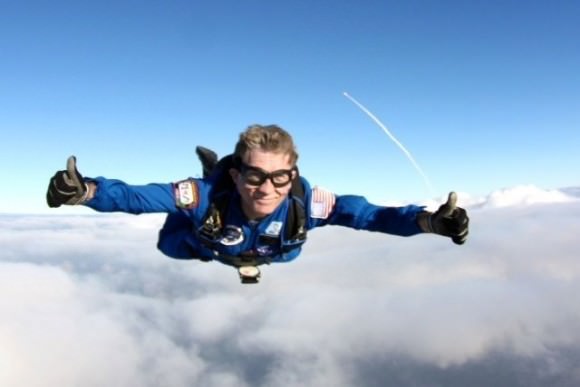
Speaking of freefall, former astronaut Fred Leslie and his wife Kathy wanted to do something special to commemorate Discovery’s final launch. They jumped from an aircraft over Deland, Fla., and timed it so they could get a photograph with Discovery taking off in the background. Read more about it in the Huntsville Times.
And of course, if you want to see more launch images, we have a great gallery of the STS-133 launch as seen by our cadre of reporters and photographers who were on hand for Discovery’s historic launch.
Incredible Video of Shuttle Approaching ISS, Taken from Earth

[/caption]
Award winning photographer Theirry Legault sent us a note about some amazing new video he shot of the space shuttle Discovery getting ready to dock with the space station. Legault took the video on Saturday evening (Feb. 26, 2011) at 18:40 UT from Germany, showing Discovery and the ISS about a hundred meters apart, 30 minutes before docking. The image above is a still frame from the video, which can be seen on Legault’s website here. “It’s sunset on the ISS at the end of the video sequence,” Legault wrote. “The video is accelerated 2.5 times (acquisition at 10 fps, video at 25 fps). The altitude of the ISS is 360 km (200 miles)… and the speed of ISS is 17,000 miles per hour (27,350 kph) and its angular speed at zenith is 1.2° per second.”
Flash is required to see the video. The 900 frames of the sequence has been registered and combined by groups of 10 (processing with Prism and VirtualDub), Legault said. Find out more about Legault’s photography and tracking equipment at this page on his website.
If you recall, Legault has also taken images of the ISS and docked shuttle Endeavour transiting the Sun, and Atlantis and the Hubble Space Telescope transiting the Sun, as well as many other amazing images shot from Earth.
The detail Legault has captured is incredible, and a joy to see. Check out more on his website.

